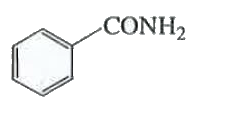An organic compound 'A' (C16H13O2N) is insoluble in dil cold aqueous alkali but on warming gives a clear solution. ‘A’ when treated with dil H2SO4 gives B(C16H15O2N) which when boiled with conc. HCl under reflux and cooled, a solid compound C(C8H6O4) is crystallized out. The mother liquor when separated and concentrated gives D(C8H12NCl).
BSoda lime−−−−−→Δ 'M' product (M) isSolution in Telugu




The correct Answer is:B
Topper's Solved these Questions
- AMINES AND AZO COMPOUNDS BOOK - AAKASH SERIESCHAPTER - AMINES AND AZO COMPOUNDS EXERCISE - PRACTICE SHEET - 4 (Match the following questions)
2 Videos
- AMINES AND AZO COMPOUNDS BOOK - AAKASH SERIESCHAPTER - AMINES AND AZO COMPOUNDS EXERCISE - PRACTICE SHEET - 4 (Integer answer type Questions)
6 Videos
- AMINES AND AZO COMPOUNDS BOOK - AAKASH SERIESCHAPTER - AMINES AND AZO COMPOUNDS EXERCISE - PRACTICE SHEET - 4 (Linked Comprehension type questions) Passage - I
3 Videos
- ALKYL AND ARYL HALIDESBOOK - AAKASH SERIESCHAPTER - ALKYL AND ARYL HALIDESEXERCISE - OBJECTIVE EXERCISE - 4 (ASSERTION (A) & REASON (R) TYPE QUESTIONS)
19 Videos
- AMINES AND DIAZONIUM SLATSBOOK - AAKASH SERIESCHAPTER - AMINES AND DIAZONIUM SLATSEXERCISE - PRACTICE EXERCISE
25 Videos
Similar Questions
Match the following columns

View SolutionExamine the structural formulas of the following compounds and identify how many are more basic than aniline


View SolutionThe isomeric compounds ‘A’ and 'B' with molecular fomula C7H9N gave the following reactions. When B is acetylated and then brominated, it gave one monobromo derivative. 'A' when treated with NaNO2 and HCI gave the compound 'C'. 'C' was heated with acetic acid in the presence of conc. H2SO4, a pleasant smelling liquid (D) was obtained. 'B' was treated with Na
‘B’ is
View Solution(A) Towards SN2 reaction, order of reactivity is CH3Br>CH3CH2Br>(CH3)2CHBr>(CH3)3CBr.
(R) Greater the stability of carbocation, greater will be its ease of formation from alkyl halide and faster will be the rate of SN1 reaction.
View SolutionIUPAC name of (C2H5)3C−NH2 is
View SolutionAn organic compound (A) (C_(5)H_(7)OCl) reacts rapidly with ethanol to give (B) (C_(7)H_(12)O_(2)) . (A) also reacts with water to produce an acid which reacts with bromine to give (C ) (C_(5)H_(8)Br_(2)O_(2)) . (B) on boiling with H_(2)SO_(4) forms an acid (D). When (D) is oxidised with KMnO_(4) an acid (E ) (C_(4)H_(6)O_(3)) is produced. On mild heating, (E ) gives (F) (C_(3)H_(6)O) which cannot be oxidised by ammoniacal AgNO_(3) . Identify the compounds (A) to (F).
View SolutionAn organic compound 'A' (C16H13O2N) is insoluble in dil cold aqueous alkali but on warming gives a clear solution. 'A' when treated with dil H2SO4 gives B(C16H15O2N) which when boiled with conc. HCl under reflux and cooled, a solid compound C(C8H6O4) is crystallized out. The mother liquor when separated and concentrated gives D(C8H12NCl)
Structure of compound 'A' can be
View SolutionAn organic compound 'A' (C_(16) H_(13) O_2 N) is insoluble in dil cold aqueous alkali but on warming gives a clear solution. 'A' when treated with dil H_2 SO_4 gives B(C_(16) H_(15) O_2 N) which when boiled with conc. HCl under reflux and cooled, a solid compound C(C_8 H_6 O_4) is crystallized out. The mother liquor when separated and concentrated gives D(C_8 H_(12) NCl) B overset("Soda Lime") underset(Delta) to 'M' , product (M) is
View SolutionAn organic compound 'A' (C_(16) H_(13) O_2 N) is insoluble in dil cold aqueous alkali but on warming gives a clear solution. 'A' when treated with dil H_2 SO_4 gives B(C_(16) H_(15) O_2 N) which when boiled with conc. HCl under reflux and cooled, a solid compound C(C_8 H_6 O_4) is crystallized out. The mother liquor when separated and concentrated gives D(C_8 H_(12) NCl) Compound 'D' can be
View SolutionAn organic compound A (C_(7)H_(6)Cl_(2)) on treatment with NaOH solution gives another compound B (C_(7)H_(6)O) . B on oxidation gives and acid C (C_(7)H_(6)O_(2)) which on treatment with a mixture of conc. HNO_(3)" and "H_(2)SO_(4) gives a compound D (C_(7)H_(5)NO_(4)) . B on treatment with conc. NaOH gives a compound E (C_(7)H_(8)O)" and "C_(6)H_(5)COONa . Deduce the structures of [A], [B], [C], [D] and [E].
View SolutionOn ozonolysis, an organic compound (A) C6H10 gives two aldehyde (B) C2H4O and (C ) C2H2O2. Determine the structure of A,B and C.
View SolutionA hydrocarbon A(C_(10)H_(12)) has no chiral carbon. A gives a white precipitate with ammonical solution of silver nitrate. A on treatment with H_(2)//pt gives B(C_(10)H_(20)) . A on ozonolysis gives C(C_(8)H_(12)O_(4)) as one product which on heating with soda lime gives D(C_(6)H_(12)) . D on monochlorination with Cl_(2)//hv gives C_(6)H_(11)Cl as sole isomer. Identify A to D .
View SolutionC3H6O4Δ−−→C3H6O2Soda lime−−−−−→ΔC2H6
The compound (A] is:
View SolutionAn organci compound C6H4O2NCl(A) reacts with a,la,oo tp gove C6H5O3N(B). On reduction with tin and HCl,(B) gives C6H7ON(C) whereas on milder reduction it gives (D)C6H7O2N, which rearranges in the presence of a mineral acid to give a new compound (E). Identify the various compounds from (A), to (E).
View SolutionAn organic compound (A) of molecular formula C5H8 when treated with Na in liquid ammonia followed by reaction with s-Propyl iodide yeidls (B) C8H12 (A) gives a ketone C5H10O (e) when treated with dil H2SO4 and HgSO4 (B) on oxidation with alkaline KMnO4 gives two isomeric acids (D) and (E) C4H8O2. Give structures of compounds (A) to (E) with proper reasoning .
View Solution


